![]()
Drying, freezing or even using the herbs we grow has been a topic of conversation with a few groups recently and one I was reminded of again during a recent chat with Orla Rapple when we were discussing the benefits of blogging and horticulture.
Many of us grow herbs in pots outside the door or in herb beds or gardens, but how often do we harvest and store them for use over the winter months?
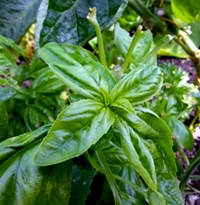
With food waste very much on the agenda after the revelation that Tesco sent 28,500 tonnes into landfill from their UK stores (not composted) in the first six months of this year, now might be a great time to think about preserving our own herbs.
There’s been many a year that I’ve regretted not collecting the leaves from my coriander (cilantro) before it went to seed or not drying the basil plants before they withered and died, yet preserving, drying or freezing herbs is a very simple exercise that will only take a short time to do.
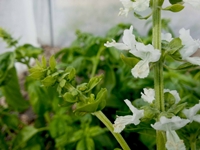
Basil ‘gone to seed’
How to dry herbs
The best time to pick herbs for drying is early to mid summer when shoots are young and fresh. If they’re left until later in the year they may become tough and flower, which can alter their flavour. However, if you’ve left it late (as we had in Callan this year with the basil), taste a leaf or two and see if you’re happy with the flavour. If you are, better to dry it than waste it!
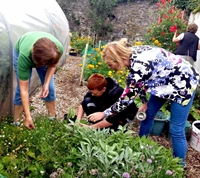
Goresbridge Community Gardeners Collecting Herbs
Here’s a few tips to help get the best flavours from preserved herbs:
- Harvest on a warm, sunny day, preferably in the morning after the dew has evaporated but before the sun has scorched them.
- To prevent flavours and aromas mingling, only pick one variety at a time.
- Check the herbs carefully, removing any damaged or diseased leaves or stems and shake them to remove any small insects.
- Tie small bunches of herbs together, ensuring that stems are preferably no more than pencil thickness. This will prevent mildew forming and allow an airflow.
- To help to keep their colour, small-leaved herbs such as thyme can be tied and dipped into boiling water briefly then shaken and allowed to dry on kitchen towel. This will also make sure any tiny insects that you might have missed on inspection are dealt with.
- Tie bunches of herbs together ensuring that stems are preferably no more than a pencil thickness which will prevent mildew forming and allow an airflow.
- Hang the bunches upside down with paper bags or muslin tied around the leaves to protect them from flies and dust.
- The best place to dry herbs is in a cool, dry shed or hot press (airing/warming cupboard). This method should take around seven to ten days.
Storing the dried herbs
Once your herbs are dry, simply crumble the dried leaves with your fingertips, discarding any stalks or spiky bits and preferably store them in small, dark, glass jars to keep their flavour.
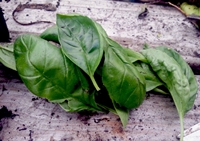
basil leaves
How to dry herbs in the oven
Air drying herbs is preferable for concentration of flavour however, speed is sometimes desired! If so herbs can be dried in the oven in about an hour.
Pick and clean the herbs as in the air drying method above but instead of tying sprigs into bunches, remove the leaves from the stems and lay out on a baking tray on top of a piece of muslin. Place the tray in an oven set at the coolest setting and leave the door slightly ajar. Turn the leaves over after about half an hour.
Freezing Herbs
Freezing is a handy method of preserving herbs but they tend to go limp when they’re defrosted so are not suitable for garnishing. They can however, be added to stews etc., straight from frozen.
Simply chop up the leaves, add them to ice-cube trays, top up with cold water and pop the trays into the freezer. When the cubes are frozen, empty them into a bag or container and add them to your soups or stews as your recipe requires. This is an ideal method for saving supermarket fresh herb bags or containers that may have been added to the shopping trolley for one or two recipes and are now left withering in the bottom of the fridge or on the windowsill.
Alternatively, divide sprigs of herbs into bags and freeze them whole. The method for picking and washing herbs is the same as those in the drying instructions above.
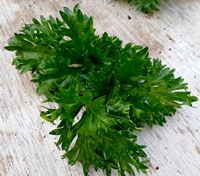
Parsley
Given that food waste is such an issue, I’m going to make an effort to dry and preserve more of my own herbs. Do you preserve yours?

Dee Sewell – a horticulturalist and certified trainer who started Greenside Up in 2009 and teaches people how to grow vegetables. Dee specialises in working with community gardens but also offers workshops, allotment visits, consultations, horticultural therapy, afterschools clubs as well as local talks – she tailors her services to meet clients needs. In 2012 Dee launched a Seed Gift Collection containing varieties of vegetable and insect friendly flowers with the aim of getting more people growing. Dee’s blog was a finalist in the 2012 Ireland Blog Awards in the Eco/Green and Lifestyle Categories.
Source: GreenSideUp – How To Dry Herbs ~ Air, Oven & Freeze – Dee Sewell




